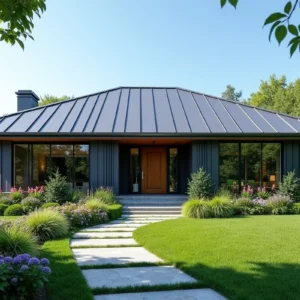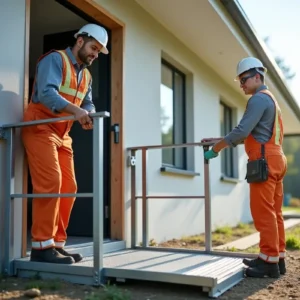Sustainable architecture is more than just a trend; it’s necessary for our planet’s future. By integrating environmentally responsible and resource-efficient processes, sustainable design aims to reduce the overall impact on the environment and human health.
This approach considers the entire lifecycle of a building, including site, design, construction, operation, maintenance, renovation, and demolition. Whether you’re an architect or a homeowner, the principles of sustainable architecture offer valuable insights and can significantly influence the way we build and live.
Contents
- 1 Core Principles of Sustainable Architecture
- 2 Environmental Benefits of Sustainable Design
- 3 Economic Advantages of Sustainable Architecture
- 4 Social Benefits of Sustainable Design
- 5 Best Practices in Sustainable Building
- 6 Innovative Materials and Technologies
- 7 Conclusion: Looking Forward to a Sustainable Future
Core Principles of Sustainable Architecture
Several fundamental principles guide sustainable architectural design. These include energy efficiency, water conservation, use of sustainable materials, and indoor environmental quality.
Energy efficiency is achieved through renewable energy sources like solar panels, wind turbines, and highly efficient HVAC systems. Water conservation efforts involve the installation of low-flow fixtures, rainwater harvesting systems, and wastewater treatment plants.
Environmental Benefits of Sustainable Design
One of the most compelling reasons to adopt sustainable architecture is its positive environmental impact. Sustainable buildings often feature energy-efficient systems and renewable energy sources, such as solar panels or geothermal heating.
These systems significantly reduce the carbon footprint of a building by lowering energy consumption and greenhouse gas emissions. For example, buildings with green roofs offer insulation and absorb rainwater, which helps reduce urban heat islands and manage stormwater.
They also prioritize water conservation through rainwater harvesting and low-flow fixtures, ensuring water resources are used judiciously. Additionally, sustainable design minimizes waste and pollution by using recycled or upcycled materials.
Recycled concrete, reclaimed wood, and environmentally friendly insulation materials are just a few examples of how sustainability can be incorporated into building design. For more information on the environmental impact of sustainable practices, this article on sustainable architecture provides a comprehensive overview.
Economic Advantages of Sustainable Architecture
While the initial costs of sustainable buildings may be higher, they offer significant financial benefits over time. Energy-efficient buildings reduce utility bills by optimizing energy consumption.
For example, buildings designed to maximize natural light can reduce the need for artificial lighting during the day, substantially cutting electricity costs. Green roofs or walls can enhance insulation, lowering heating and cooling costs. Over time, these savings can offset the initial investment in sustainable technologies.
Many studies show that sustainable buildings often have higher property values and can attract environmentally conscious tenants or buyers, making them a worthwhile investment.
Additionally, certain governments offer tax incentives and rebates for sustainable buildings, further enhancing their financial appeal. Research indicates that occupants of sustainable buildings frequently experience lower operating costs, contributing to a better overall return on investment.
Social Benefits of Sustainable Design
Sustainable architecture also offers notable social benefits. Healthier indoor environments, achieved through better air quality and natural lighting, can improve occupants’ health and productivity.
Studies suggest that employees working in green buildings experience lower levels of stress and increased job satisfaction, which can boost overall productivity. This can translate to significant benefits for employers, including reduced absenteeism and excellent employee retention.
Furthermore, sustainable buildings can foster a greater sense of community by incorporating communal spaces and encouraging interaction. Rooftop gardens, shared courtyard spaces, and multi-use common areas can serve as vital community hubs, strengthening social ties among residents.
Additionally, the aesthetic appeal of sustainable buildings can elevate the sense of pride and ownership among occupants and the surrounding community.
Best Practices in Sustainable Building
Professionals employ various strategies and tools to achieve the best results in sustainable architecture. Passive solar design, for instance, takes advantage of natural heat and light to reduce dependency on mechanical heating and cooling systems. Proper building orientation, strategic window placement, and thermal mass are critical elements of passive solar design that can be incorporated into any building project.
Green building certification programs like LEED (Leadership in Energy and Environmental Design) provide a framework for measuring and achieving sustainability. LEED certification can guide architects and developers in implementing best practices and achieving sustainability goals on a project.
Additionally, utilizing Building Information Modeling (BIM) allows for more efficient planning and management of resources throughout a project’s lifecycle. BIM software enables project teams to visualize and optimize energy efficiency, material usage, and building performance before construction begins.
Innovative Materials and Technologies
The choice of materials and technologies plays a crucial role in sustainable architecture. Innovations such as cross-laminated timber (CLT) provide a renewable alternative to traditional materials like steel and concrete. CLT reduces the environmental impact of construction and offers superior strength and durability. Similarly, bamboo and recycled steel are gaining popularity due to their eco-friendly characteristics.
Advancements in intelligent technology enable more efficient energy management, with smart thermostats, lighting controls, and energy monitoring systems playing significant roles. Natural elements like living walls or green roofs can also enhance a building’s ecological footprint.
These features improve air quality, reduce energy consumption, and provide occupants with aesthetic and mental health benefits. As technology evolves, architects have a growing array of innovative tools to enhance sustainability.
Conclusion: Looking Forward to a Sustainable Future
The push for sustainable architecture is gaining momentum as awareness of environmental issues grows. By embracing sustainable practices and materials, we can create buildings that are functional, aesthetically pleasing, and environmentally responsible. The future of architecture lies in the balance between human needs and the health of our planet – a delicate balance that sustainable design strives to achieve.





